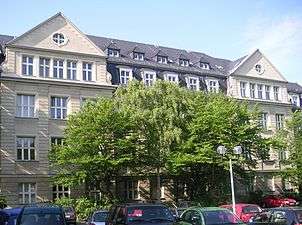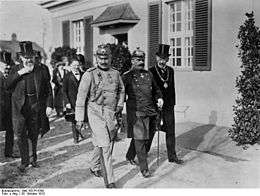Kaiser Wilhelm Society

The Kaiser Wilhelm Society for the Advancement of Science (German Kaiser-Wilhelm-Gesellschaft zur Förderung der Wissenschaften) was a German scientific institution established in the German Kaiserreich in 1911. During the Third Reich it was involved in Nazi scientific operations, and after World War II concluded, its functions were taken over by the Max Planck Society. The Kaiser Wilhelm Society was an umbrella organization for many institutes, testing stations, and research units spawned under its authority.
Constitution

The Kaiser Wilhelm Gesellschaft (KWG) was founded in 1911 in order to promote the natural sciences in Germany, by founding and maintaining research institutions formally independent from the state and its administrations. The institutions were to be under the guidance of prominent directors, which included luminaries such as Walther Bothe, Peter Debye, Albert Einstein, Fritz Haber, and Otto Hahn; a board of trustees also provided guidance.
Funding was ultimately obtained from sources internal and external to Germany. Internally, money was raised from individuals, industry, and the government, as well as through the Notgemeinschaft der Deutschen Wissenschaft (Emergency Association of German Science).
External to Germany, the Rockefeller Foundation granted students worldwide one-year study stipends, for whichever institute they chose, some studied in Germany.[1][2][3] In contrast to the German universities with their formal independence from state administrations, the institutions of the Kaiser Wilhelm Gesellschaft had no obligation to teach students.
The Kaiser Wilhelm Institute and its research facilities were involved in weapons research, experimentation and production in both World War I and World War II.
After World War II
By the end of World War II, the KWG and its institutes had lost their central location in Berlin and were operating in other locations. The KWG was operating out of its Aerodynamics Testing Station in Göttingen. Albert Vögler, the president of the KWG, committed suicide on 14 April 1945. Thereupon, Ernst Telschow assumed the duties until Max Planck could be brought from Magdeburg to Göttingen, which was in the British zone of the Allied Occupation Zones in Germany. Planck assumed the duties on 16 May until a president could be elected. Otto Hahn was selected by directors to be president, but there were a number of difficulties to be overcome. Hahn, being related to nuclear research had been captured by the allied forces of Operation Alsos, and he was still interned at Farm Hall in England, under Operation Epsilon. At first, Hahn was reluctant to accept the post, but others prevailed upon him to accept it. Hahn took over the presidency three months after being released and returned to Germany. However, the Office of Military Government, United States (OMGUS) passed a resolution to dissolve the KWG on 11 July 1946.
Meanwhile, members of the British occupation forces, specifically in the Research Branch of the OMGUS, saw the Society in a more favorable light and tried to dissuade the Americans from taking such action. The physicist Howard Percy Robertson was director of the department for science in the British Zone; he had a National Research Council Fellowship in the 1920s to study at the Georg-August University of Göttingen and the Ludwig Maximilians University of Munich. Also, Colonel Bertie Blount was on the staff of the British Research Branch, and he had received his doctorate at Göttingen under Walther Borsche. Among other things, Bertie suggested to Hahn to write to Sir Henry Hallett Dale, who had been the president of the Royal Society, which he did. While in England, Bertie also spoke with Dale, who came up with a suggestion. Dale believed that it was only the name which conjured up a pejorative picture and suggested that the Society be renamed the Max Planck Gesellschaft. On 11 September 1946, the Max Planck Gesellschaft was founded in the British Zone only. The second founding took place on 26 February 1948 for both the American and British occupation zones. The physicists Max von Laue and Walther Gerlach were also instrumental in establishing the Society across the allied zones, including the French zone.[4][5]
Presidents
- Adolf von Harnack (1911–1930)
- Max Planck (1930–1937)
- Carl Bosch (1937–1940)
- Albert Vögler (1941–1945)
- Max Planck (16 May 1945 – 31 March 1946)
- Otto Hahn (1 April 1946 – 10 September 1946 in the British Occupation Zone)
Institutes, testing stations, and units
Kaiser Wilhelm Institutes
- KWI for Animal Breeding Research, founded in Dummerstorf. Transformed into a research institute of the (East)-German Academy of Sciences.
- KWI of Anthropology, Human Heredity, and Eugenics, founded 1926 in Berlin-Dahlem.
- KWI for Bast Fiber Research, founded 1938 in Sorau. It was relocated to Mährisch Schönberg in 1941 and to Bielefeld in 1946. After its incorporation into the Max Planck Society in 1948 and two further relocations to Westheim and Niedermarsberg in 1951 it was incorporated into the Max Planck Institute for Breeding Research and relocated to Köln-Vogelsang. The Institute was closed down in 1957. Its first director was Ernst Schilling 1938-1945 and 1948-1951.
- KWI for Biology, founded 1912 in Berlin and moved to Tübingen in 1943. It is now the Max Planck Institute for Biology.
- KWI for Biochemistry, founded 1912. Nowadays, there exists the Max Planck Institute of Biochemistry, but there is no straight relation between the institutes.
- KWI for Biophysics, formerly the Institut für Physikalische Grundlagen der Medizin of Friedrich Dessauer was incorporated into the KWG by Boris Rajewsky in 1937. The Institute is located in Frankfurt am Main. It is now the Max Planck Institute for Biophysics.
- KWI for Brain Research, founded 1914 in Berlin by Oskar Vogt. It is now the Max Planck Institute for Brain Research.
- KWI for Cell Physiology, founded 1930 in Dahlem, Berlin by Otto Heinrich Warburg and the Rockefeller Foundation.
- KWI for Chemistry, founded 1911 in Dahlem. It is now the Max Planck Institute for Chemistry, also known as the Otto Hahn Institute.
- KWI for Coal Research Institute of the KWG, founded 1912 in Mülheim. It is now the Max Planck Institute für Kohlenforschung.
- KWI for Comparative and International Private Law, founded 1926 in Berlin by Ernst Rabel.[6] It is now the Max Planck Institute for Comparative and International Private Law in Hamburg.
- KWI for Comparative Public Law and International Law, founded 1924 in Berlin; the first director was Viktor Bruns.[7] It is now the Max Planck Institute for Comparative Public Law and International Law in Heidelberg.
- KWI for Experimental Therapy, founded in 1915 by August von Wasserman.
- KWI for Fiber Chemistry, founded in 1920 by Reginald Oliver Herzog, closed in 1934.
- KWI of Flow (Fluid Dynamics) Research, founded 1925. Ludwig Prandtl was the director from 1926 to 1946. It is now the Max Planck Institute for Dynamics and Self-Organization.
- KWI for German History, founded 1917 in Berlin. It was later the Max Planck Institute for History, now transformed a Max Planck Institute for multi-ethnic societies.
- KWI for Hydrobiological Research. One of its directors was August Friedrich Thienemann.
- KWI for Iron Research, founded 1917 in Aachen and it moved to Düsseldorf in 1921. It is now the Max Planck Institute for Iron Research GmbH.
- KWI for Leather Research, founded 1921 in Dresden by Max Bergmann. It became a part of an institute that later the Max Planck Institute of Biochemistry in Martinsried.
- KWI for Medical Research founded 1929 in Heidelberg by Ludolf von Krehl. It is now the Max Planck Institute for Medical Research in Heidelberg.
- KWI for Metals Research, founded 1921 in Neubabelsberg. It closed in 1933 and reopened in Stuttgart in 1934. It is now the Max Planck Institute for Metals Research in Stuttgart.
- KWI for Plant Breeding Research, founded in Müncheberg in 1929 by Erwin Baur. It is now the Max Planck Institute for Plant Breeding Research located in Cologne.
- KWI for Physical Chemistry and Electrochemistry, founded 1911 in Dahlem, Berlin. It is now the Fritz Haber Institute of the MPG, named after Fritz Haber, who was the director 1911-1933.
- KWI for Physics, founded 1917 in Berlin. Albert Einstein was the director 1917-1933; in 1922, Max von Laue became deputy director and took over administrative duties from Einstein. It is now the Max Planck Institute for Physics; also known as the Werner Heisenberg Institute.
- KWI for Physiology of Effort (Work)/KWI for Occupational Physiology, founded 1912 in Berlin, moved to Dortmund in 1929. It is now the Max Planck Institute for Molecular Physiology in Dortmund.
- German Research Institute for Psychiatry (a Kaiser Wilhelm institute) in Munich. It is now the Max Planck Institute of Psychiatry.
- KWI for Silicate Research, founded 1926 in Berlin-Dahlem by Wilhelm Eitel.
- KWI for Textile Chemistry
- KWI Vine Breeding
Kaiser Wilhelm Society organizations
- Aerodynamic Testing Station (Göttingen e. V.) of the Kaiser Wilhelm Society. The testing unit Aerodynamische Versuchsanstalt (AVA) was formed in 1925 along with the KWI of Flow (Fluid Dynamics) Research. In 1937, it became the testing station of the KWG.
- Biological Station Lunz of the Kaiser Wilhelm Society
- German Entomological Institute of the Kaiser Wilhelm Society
- Hydrobiological Station of the Kaiser Wilhelm Society
- Institute for Agricultural Work Studies in the Kaiser Wilhelm Society
- Research Unit "D" in the Kaiser Wilhelm Society
- Rossitten Bird Station of the Kaiser Wilhelm Society, founded 1901 in Rossitten and integrated into the Kaiser Wilhelm Society in 1921. The ornithological station was ceased at the end of the Second World War, but work continues at the ornithological station Radolfzell which is part of the Max Planck Institute for Ornithology.
- Silesian Coal Research Institute of the Kaiser Wilhelm Society, in Breslau.
Institutions outside Germany
- Bibliotheca Hertziana, founded 1913 in Rome. It is now the Bibliotheca Hertziana - Max Planck Institute of Art History in Rome.
- German-Bulgarian Institute for Agricultural Science founded in 1940 in Sofia.
- German-Greek Institute for Biology in the Kaiser Wilhelm Society founded in 1940 in Athens.
- German-Italian Institute for Marine Biology at Rovigno, Italy.
- Kaiser Wilhelm Institute for Cultivated Plant Research founded in 1940 in Vienna, Austria.
Other
- Institute for the Science of Agricultural Work—founded in 1940 in Breslau.
- Research Unit for Virus Research of the Kaiser Wilhelm Institute for Biochemistry and the Kaiser Wilhelm Institute for Biology
- Institute for Theoretical Physics
See also
Notes
- ↑ Macrakis, 1993, 11-28 and 273-274.
- ↑ Hentschel, 1996, Appendix A; see the entries for the Kaiser Wilhelm Gesellschaft and the Kaiser Wilhelm Institute for Fluid Dynamics Research.
- ↑ List of Kaiser Wilhelm Institutes in summary of holdings, Section I (Bestandsübersicht, I. Abteilung), on the website of the Max Planck Gesellschaft Archives (in German). Retrieved 2015-08-29.
- ↑ Macrakis, 1993, 187-198.
- ↑ Hentschel, 1996, Appendix A; see the entries for the Kaiser Wilhelm Gesellschaft and the Kaiser Wilhelm Institute for Fluid Dynamics Research.
- ↑ Kunze, Rolf-Ulrich (2004). Ernst Rabel und das Kaiser-Wilhelm-Institut für ausländisches und internationales Privatrecht 1926-1945. Göttingen: Wallstein. p. 13.
- ↑ Kunze (2004), p. 47-48.
Bibliography
- Hans-Walter Schmuhl: Grenzüberschreitungen. Das Kaiser-Wilhelm-Institut für Anthropologie, Menschliche Erblehre und Eugenik 1927–1945. Reihe: Geschichte der Kaiser-Wilhelm-Gesellschaft im Nationalsozialismus, 9. Wallstein, Göttingen 2005, ISBN 3-89244-799-3
- Hentschel, Klaus (ed.) (1996). Physics and National Socialism: An Anthology of Primary Sources. Basel, Boston: Birkhäuser Verlag. ISBN 0-8176-5312-0.
- Macrakis, Kristie (1993). Surviving the swastika: Scientific research in Nazi Germany. New York: Oxford Univ. Press. ISBN 0-19-507010-0.
External links
- History of the Kaiser Wilhelm Society in the National Socialist Era - Presidential Commission of the Max Planck Gesellschaft
- KWG & MPG Presidents
- A History of the Kaiser Wilhelm Institute for Medical Research: 1929-1939, by David M. States (June 28, 2001) – compilation of articles, including several about the lives and work of Nobel laureates, on the official website of the Nobel Prize
- Kaiser-Wilhelm-Gesellschaft 1911-1948 (in German) – Deutsches Historisches Museum
- Max Planck Gesellschaft – English Portal